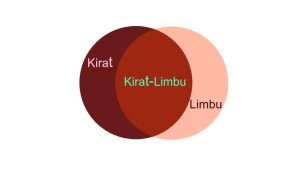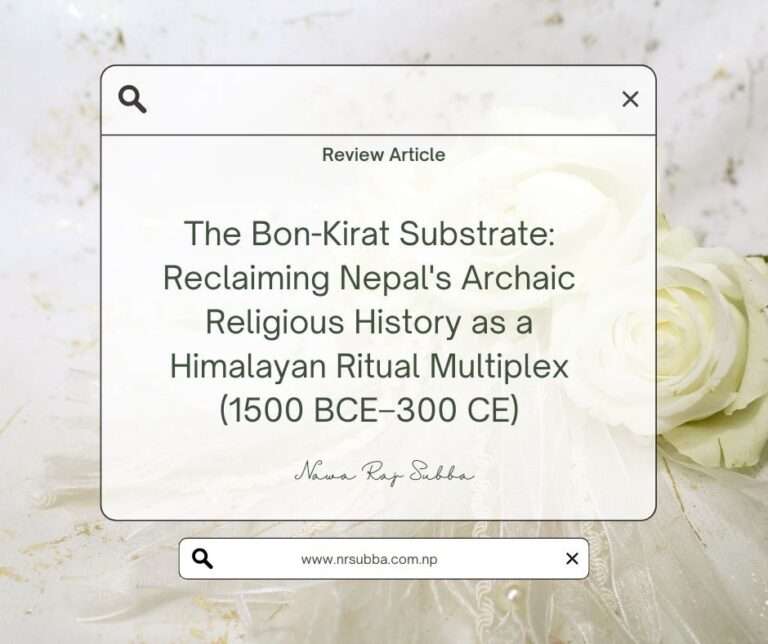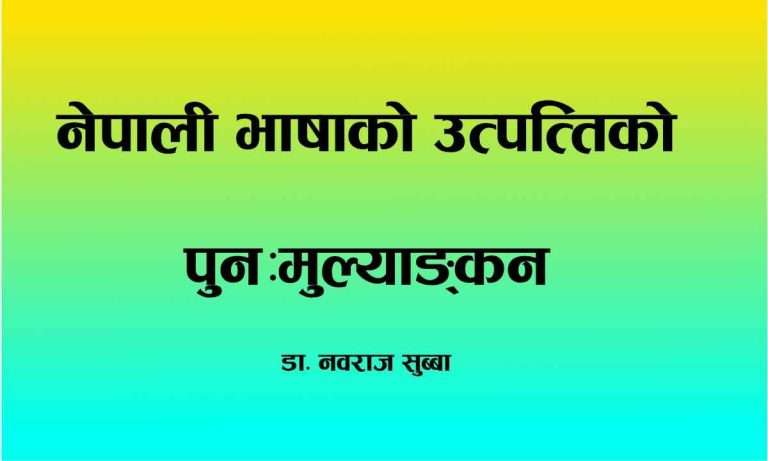Analyzing the Kirat and Limbuwan Arguments in Nepal’s Province No. 1 Naming Controversy

Dr. Nawa Raj Subba
Abstract
After the formation of federal Nepal in 2015, the country formed seven provinces. Each province had the right to choose its name. There was a heated debate on naming Province No. 1, located in eastern Nepal. Two major groups, Kirat and Limbuwan, have advocated different names. The controversy over whether or not to name the province “Kirat” or “Limbuwan” reflects deep historical, cultural, and political differences between these communities. This article understands the historical context and cultural identity of the Kirat and Limbuwan tribes as naming complexities. This article aims to critically comment on the studies done on this question. Content available online is the basis of the article.
The core of the issue is the historical subjugation of the indigenous people and their absence from the nation’s socioeconomic and political mainstream. Studies have concluded that Kirat and Limbuwan campaigns have been carried out to control their communities and prevent cultural identity from being erased. The study said that conflicts will likely be reduced as federalism and identity are intertwined by giving political and economic opportunities to address their concerns.
Introduction
Nepal’s federal restructuring in 2015 brought about significant changes. According to which the provinces were formed. Of these, the name of Province No. 1 in the eastern part of the country became the center of political controversy. Debates emerged about the proposed names “Kirat” and “Limbuwan,” reflecting deeply historical, cultural, and identity-based issues. This article examines the causes of the province naming controversy over the tension between Kirat and Limbuwan identities. The article is based on expert analysis grounded on historical and socio-political factors.
Historical background of Kirat and Limbuwan
Kirat is indigenous to Nepal and traditionally lives in eastern Nepal. The Rai, Limbu, Sunuwar, and Yakkha ethnicities claim to be Kirat. Historically, the Kirat civilization is widely believed to have ruled parts of present-day eastern Nepal and northern India. Kirat rule extended to the Kathmandu Valley until the Lichchavi dynasty captured it (Subba, 1999).
“Limbuwan” refers to the Limbu tribe, one of the Kirat communities, and their historical terrain. Limbuwan was an autonomous region before it was merged into the Gorkha state in the late 18th century (Caplan, 1970). The Limbu people want to maintain Limbuwan’s historical autonomy as it has its unique identity within the larger Kirati framework. On political, social, and cultural grounds, they have also tried to establish their identity in their land in federal Nepal.
Underlying causes of the nomenclature controversy
1. Historical Autonomy and Identity Preservation
Limbu, one of the major tribes within the Kirat group, has a distinct identity. This identity has evolved over the centuries. Limbu originated from ancient Kirat warriors. They once ruled parts of the eastern Himalayas. Due to the Limbu people’s special history, language, and culture, they consider themselves a different tribe. Historically, until the latter part of the 18th century, the Limbu people who lived in the region maintained a certain degree of autonomy. Prithvi Narayan Shah’s reign brought the annexation of Limbuwan into the enlarged Gorkha realm. (Caplan, 1970)
A complicated and sometimes controversial relationship between the Limbu ethnic groups and the central state began with the integration of Limbuwan into the Gorkha state. Limbus complains that land rights have been given, but cultural repression exists. They also have a deep wound, and Kipat’s right has been taken away unilaterally by the Centre. Despite this, the Limbu community has maintained a strong sense of identity with its language, customs, and social structure. Therefore, the name “Limbuwan” has an important historical and cultural meaning for the Limbu people. They consider it a symbol of their unique identity and heritage (Chemjong, 1967).
2. Ethnic identity and political representation
The argument over the designation of Province 1 has brought to the forefront the problems of ethnic identity and political representation in Nepal. Upper-caste Hindus have always controlled Nepali society and culture. The Limbu ethnicity and other ethnic groups have been struggling for rights within such an ethnic nation for a long time. If the province is named “Limbuwan”, their identity and political representation in the new federal structure will be protected (Lawati, 2007). In contrast, the name “Kirat” encompasses many ethnic groups. While the name is inclusive, it can undermine the unique identity of the Limbus.
3. Nomenclature’s significance and cultural identity.
The political and cultural identities are the primary factors influencing the debate over the renaming of Province 1 in Nepal. “Kirat” refers to their common ancestry and historical connections to the area.
The Kirat community considers this name a recognition of their ancestral affiliation and contribution to Nepal’s history and culture (Sharma, 2013). Naming the province “Kirat” recognizes the heritage of the Kirat civilization and confirms its place in the nation’s history.
The Limbuwan society, on the other hand, considers the name “Limbuwan” as their distinct identity within the broader Kirat domain. The Limbus argue that their distinctive history, language, and culture have made them different from other Kirat tribes. Therefore, the name of this province should be “Limbuwan.” It appreciates their unique contribution and heritage. The name “Limbuwan” also confirms the history of the Limbu rule before they merged with the Gorkha state (Subba, 1999).
Another important reason for the naming controversy is the cultural and linguistic differences between the Limbu and other Kirati groups. Although the Limbu language Yakthungpan belongs to other Tibeto-Burman or Kirati communities, it has its script and distinct linguistic tradition. In addition, the Limbu ethnicity has typical cultural practices and religious beliefs. Although there are some similarities to the Kirati traditions, the Limbus have a unique cultural heritage and customs. They want to preserve and promote (Van Dream, 2001). The name “Limbuwan” will highlight these unique aspects of Limbu culture. The other term, “Kirat,” may overshadow it.
4. Political mobilization and identity politics
Nepal’s federal restructuring has given rise to new forms of political mobilization. Ethnic identity has become a major factor in regional politics. The “Limbuwan” demand of the Limbu ethnicity has widened Nepal’s political identity trend. Ethnic groups are claiming their rights. Different ethnicities seek greater autonomy within the federal structure (Gellner, 2007). Thus, the controversy over the name of Province No. 1 has added to the importance of ethnic identity in Nepali politics and the challenge of balancing those identities within a unified nation-state.
Nomenclature is not just a cultural issue. It has significant political impacts. The name of the province is symbolic because it indicates the identity of a particular group and its area within the national framework. For the Kirat and Limbuwan communities, the name of Province No. 1 is seen as an acknowledgment of their history and a recognition of their culture (Gellner, 2016).
The discussion also highlighted the issue of ethnic identity and regional autonomy in Nepal. The country’s entry into federalism addressed the demands of different castes and ethnicities for greater freedom and recognition. However, the dispute over the naming of Province No. 1 has the challenge of balancing that demand with the need to maintain national unity. The tensions between Kirat and Limbuwan supporters make it clear that incorporating ethnic identities within the framework of the federal state is complex (Bhattacharya, 2010).
Challenges and possible solutions
It is challenging for policymakers to address this complex, interconnected issue of history, culture, and politics. Although Province No. 1 has been renamed Koshi, the challenge has not diminished. One possible solution is to name the province by incorporating both “Kirat” and “Limbuwan” to recognize the contributions of both communities. This strategy may solve both groups’ issues while promoting inclusiveness and unity (Sharma, 2013).
An alternative approach is to initiate a voting process among the people of Province 1 to choose the name, which offers the chance to address issues through public involvement. This option is from a democratic point of view. Of course, the representatives elected by the people also reflect the will of the people. The people or people’s representatives are responsible for the province’s identity (Gellner, 2016). If the tensions created by the majority rejecting the wishes of the minority are not properly addressed, it can have far-reaching effects.
Conclusion
Based on what people back in Kirat and Limbuwan are saying, facts and proof have been found. The piece tries to explain the conflict. The data will inform the analysis of Nepal’s ethnic identity and regional rights.
After a long argument, Province 1 was renamed Koshi Province on August 4, 2021. This incident is a big event in Nepali history. This choice comes from the Nepali Constitution of 2015 BS and is crucial in the country’s federalism movement.
The Kirat and Limbu communities do not like the name because it goes against the main idea of federalism. There is now an atmosphere of these kinds of conflicts. Experts say historical, cultural, and political problems are the root of this conflict. So, the subject is quickly examined by looking at what different studies have found. This study will discuss political, social, and cultural facts.
Many political, cultural, and historical factors impact the disagreement over the name of Nepal’s Province 1. Some of these are identity protection, historical self-government, and political participation. The problems with “Kirat” and “Limbuwan” are only the beginning. They point to bigger problems that Nepal’s federal government has not fully solved.
Main reason
This identity problem is very much affected because the Kirat and Limbu communities are going through a crisis of identity right now. A complicated web of social, cultural, and political factors leads to this question. The main reason is that Indigenous people are being pushed to the edges and mistreated. Nepal’s general society has kept these ethnic groups out of the mainstream. Kirat and Limbu have been cut off from their towns because of wrongdoing and neglect in the past. Because of this, they must be publicly active to protect their culture.
The main story in Nepal did not mention the unique arts and cultural practices of some Kirats and Limbus and tried to shut them down. Thus, their feelings of fear and dissatisfaction got worse. To solve this situation, the Kirat and Limbu communities have united with a sense of ethnic pride and unity.
Recommendation
Reducing the crisis and making it easier for more people to be heard in politics can help poor places become equal. Nepali society should understand and value the important things that the Kirat and Limbu communities, who have been outside, have done and learned. Giving them your attention to their worries can help you find an answer.
References
Bhattacharya, N. (2010). Ethnic identity and regional autonomy in Nepal. Routledge.
Caplan, L. (1970). Land and Social Change in East Nepal: A Study of Hindu-Tribal Relations*. Routledge.
Chemjong, I. S. (2003). History and Culture of the Kirat People. Kirat Yakthung Chumlung.
Gellner, D. N. (2007). Resistance and the State: Nepalese Experiences. Berghahn Books.
Lawoti, M. (2007). Political Exclusion and Ethnic Conflict in Nepal: Mobilization, Democratization, and the New Dynamics of Inclusion. Himal Books.
Sharma, P. (2013). Culture and Identity in the Kirat Community*. Himal Books.
Subba, T. B. (1999). Politics of Culture: A Study of Three Kirata Communities in the Eastern Himalayas. Orient Longman.
van Driem, G. (2001). Languages of the Himalayas: An Ethnolinguistic Handbook of the Greater Himalayan Region. Brill.
Email- [email protected] Copyright (c) 2024 Nawa Raj Subba.
further reading Kirat federation From Kipat to Kathmandu




